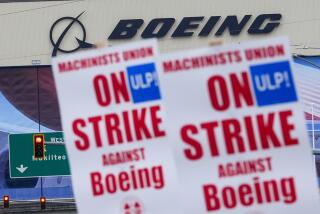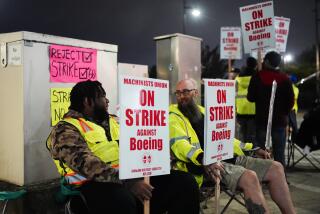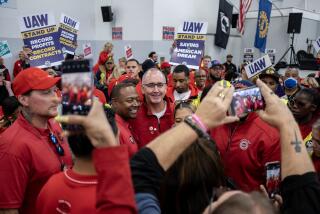Win Could Hurt Eastern Strikers
Embattled strikers at Eastern Airlines won a nice little psychological victory last week, but it could end up doing them more harm than good.
The victory came when a federal grand jury indicted the airline and 10 former and current Eastern managers on criminal conspiracy charges, alleging that they put the lives of passengers at risk by keeping fraudulent maintenance and safety records.
The indictments mirrored long-ignored charges by the employeesâ unions, the International Assn. of Machinists and the Air Line Pilots Assn.
And government officials are stressing that the Eastern investigation, headed by Andrew Maloney, the U.S. Attorney in New York, is not over.
That means that it may finally involve the man the union workers hate most: Frank Lorenzo, head of Easternâs parent, Continental Airlines Holdings Inc. Neither Lorenzo nor other top Eastern executives were indicted.
Government agencies responsible for airline safety had generally dismissed the unionsâ charges as labor propaganda.
Even more reprehensible was former Transportation Secretary James Burnley, a Reagan appointee who repeatedly accused Easternâs unions of playing politics with their charges. Finally, his department gave Eastern a clean bill of health on safety just four months before he resigned his post to join a law firm representing Lorenzo.
But the grand jury vindication of the unionsâ allegations wonât end the long, bitter strike against Eastern, which is still owned mostly by Lorenzo, one of the nationâs most ruthless anti-union executives.
Instead, the grand juryâs action might make it more difficult for Northwest Airlines Chairman Alfred Checchi or someone like him to rescue the strikers by buying part or all of Eastern.
Checchi is in discussions with Eastern and its creditorsâ advisers about Northwest taking over some of Easternâs assets and then helping sell other parts of the company.
It could be a good buy because Eastern still has valuable assets, especially its gates and routes in the Southeast.
But if Eastern is maintained as a separate airline, a buyer will have to overcome the damaging publicity that goes along with those criminal indictments, in addition to the problems caused by continuing labor turmoil at Eastern.
And waiting in the wings are the Eastern pilots, who claim that they have evidence for the grand jury showing that there was a cover-up of past unsafe practices in the actual flying of the planes.
So far, the grand jury investigation has dealt only with alleged unsafe maintenance of planes while they were on the ground.
However, if the pilots succeed in proving their allegation, it might make Eastern even less attractive to Checchi or some other buyer.
The last union victory came a few months ago when a bankruptcy judge kicked Lorenzo out as Easternâs chief executive. It was a move the unions had demanded because Lorenzo provoked the machinistsâ strike by demanding drastic wage and benefit cuts after the workers had already accepted substantial reductions.
Then Lorenzo âpermanently replacedâ most of the strikers and the pilots and flight attendants who honored the machinistsâ picket lines.
Soon after the machinists went on strike in March, 1989, Lorenzo put Eastern into a Chapter 11 bankruptcy to stave off creditors, keep the airline flying and break the unions.
The ouster of Lorenzo was the first labor victory in the long dispute, and things looked even better for the strikers when the court appointed Martin Shugrue as trustee to run the company.
Known as an executive who worked well with unionized workers, Shugrue promised to make compromises with the unions to end the strike and bring labor peace to the troubled airline.
But negotiations stalled quickly because no way has been found to end the dispute since Shugrue so far has refused to get rid of the strikebreakers and rehire the strikers that Lorenzo still insists have been âpermanently replaced.â
At present, only the machinists are officially on strike; they struck March 4, 1989. But now the pilots are threatening to call their own strike because contract negotiations are deadlocked over the issue of the strikebreakers.
The best way out of Easternâs current mess would be for the unions and Shugrue to agree on new contracts, which would be possible if Shugrue rehires Easternâs experienced employees who have fought and sacrificed so long in their battle against Lorenzoâs unrelenting union-busting tactics.
Ending the labor war would make it easier to sell the company and possibly merge it with another airline, such as Northwest.
One tangible gain for the unions did come out of the grand jury indictments against Eastern and some of its officers.
Although their allegations of dangerous safety practices had been ignored by the Department of Transportation and most other government agencies, Lorenzo took them seriously.
He filed a $1.5-billion suit against the unions, complaining that their allegations were lies meant to smear the companyâs name and frighten passengers away.
His lawsuit has been weakened badly if not destroyed by the grand jury indictments, since they support the unionsâ charges.
Even before that suit and the unionsâ countersuits are dropped, though, Shugrue and the unions must concentrate on getting contract agreements that would settle the long labor dispute.
The removal of picket lines and the return of experienced Eastern workers to their jobs in the air and on the ground could help make a success of the companyâs costly advertising campaign to reassure the traveling public about Easternâs safety.
And that, in turn, should make Eastern a good deal for any prospective buyer.
More to Read
Inside the business of entertainment
The Wide Shot brings you news, analysis and insights on everything from streaming wars to production â and what it all means for the future.
You may occasionally receive promotional content from the Los Angeles Times.










